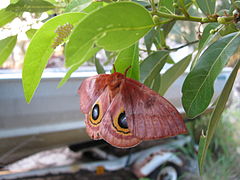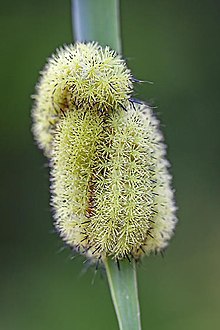Automeris io
This article includes a list of general references, but it lacks sufficient corresponding inline citations. (July 2017) |
| Io moth | |
|---|---|

| |
| Female (top) and male (below) | |
| Scientific classification | |
| Domain: | Eukaryota |
| Kingdom: | Animalia |
| Phylum: | Arthropoda |
| Class: | Insecta |
| Order: | Lepidoptera |
| Family: | Saturniidae |
| Genus: | Automeris |
| Species: | A. io
|
| Binomial name | |
| Automeris io | |
| Subspecies[3] | |
| |
| Synonyms[4] | |
| |
Automeris io, the Io moth (EYE-oh) or peacock moth, is a colorful North American moth in the family Saturniidae.[5][6] The Io moth is also a member of the subfamily Hemileucinae.[7] The name Io comes from Greek mythology in which Io was a mortal lover of Zeus.[8] The Io moth ranges from the southeast corner of Manitoba and in the southern extremes of Ontario, Quebec, New Brunswick and Nova Scotia in Canada, and in the US it is found from Montana, North Dakota, South Dakota, Nebraska, Colorado, New Mexico, Texas, Utah, east of those states and down to the southern end of Florida.[9] The species was first described by Johan Christian Fabricius in 1775.
Adult description

Imagines (sexually mature, reproductive stage) have a wingspan of 2.5–3.5 inches (63–88 mm).[7][9] This species is sexually dimorphic: males have bright yellow forewings, body, and legs, while females have reddish-brown to purple forewings, body, and legs.[4][10] The males also have much bigger plumose (feathery) antennae than the females.[4] Both males and females have one big black to bluish eyespot with some white in the center, on each hindwing.[10][11][12] Some hybridizations have resulted in variations in these hindwing eyespots.[11][12] Adults live 1–2 weeks.

Parasitoids
Many species of flies (Tachinidae) and wasps (Ichneumonidae and Braconidae) are known parasitoids.[4] The flies include the introduced Compsilura concinnata, Lespesia sabroskyi, Chetogena claripennis, Carcelia formosa, Sisyropa eudryae, Lespesia frenchii, and Nilea dimmocki.[13] The wasps include the Ichneumonidae species Hyposoter fugitivus and Enicospilus americanus,[4] and the Braconidae species Cotesia electrae and Cotesia hemileucae.[4]
Predators
Io moths have many predators. These include birds, small mammals, and spiders.[4][10]
Defenses
Stinging spines of caterpillar Io moths have a very painful venom that is released with the slightest touch. There are two hypotheses regarding where this venom originates: (1) the glandular cells on the base of the branched seta or (2) from the secretory epithelial cells.[14] Contacting the seta is not life-threatening for humans, but still causes irritation to the dermal tissue, resulting in an acute dermatitis called erucism.[15][16] Both male and female adult io moths utilize their hindwing eyespots in predatory defense when the moth is sitting in the head-down position or is touched, via shaking and exposing these eyespots.[11][12][10]
Life cycle
Females lay small, white
- Morus alba—mulberry
- Prunus pensylvanica—pin cherry
- Salix—willow
- Abies balsamea—balsam fir
- Acer rubrum—red maple
- Amorpha fruticosa—bastard indigo
- Baptisia tinctoria—wild indigo
- Carpinus caroliniana—American hornbeam
- Celtis laevigata—sugarberry or southern hackberry
- Cephalanthus occidentalis—button-bush
- Cercis canadensis—eastern redbud
- Chamaecrista fasciculata—showy partridge pea
- Comptonia peregrina—sweetfern
- Cornus florida—flowering dogwood
- Corylus avellana—common hazel
- Erythrina herbacea—coral bean[17]
- Fagus—beech
- Fraxinus—ash
- Liquidambar styraciflua—American sweetgum
- Lythrum salicaria—introduced purple loosestrife[18]
- Quercus—oakleaf

Eggs, about 48 hours after they were laid, on a bay tree - Paeonia—peony
- Phoenix roebelenii[citation needed]

The eggs have large micropyle rosettes that turn black as the fertile eggs develop. They are usually laid in clusters of more than twenty and hatch within 8–11 days.[4][10] From the eggs, orange larvae emerge, usually eating their egg shell soon after hatching.[4] They go through five instars, each one being a little different.

The

Adult Io moths normally emerge from their cocoons in late morning or early afternoon. The emergence of the adults moths is typically from June to July.) pumped from the body. This inflation process takes about twenty minutes. Adult moths are strictly
Conservation status
The Io moth has not been evaluated for listing on the IUCN Red List and has no special status on the U.S. Federal List.[19] In the eastern range of the US, the populations indicate a declining and more localized trend.[22][19]

See also
- Aglais io, a butterfly species
References
- ^ NatureServe (May 5, 2023). "Automeris io". NatureServe Network Biodiversity Location Data accessed through NatureServe Explorer. Arlington, Virginia: NatureServe. Retrieved May 19, 2023.
- OCLC 559265566. Retrieved March 15, 2018.
- ^ "Automeris io (Fabricius, 1775)". Integrated Taxonomic Information System. Retrieved May 19, 2023.
- ^ a b c d e f g h i j k l m n Hall, Donald W. (November 2014). "Featured Creatures: Io moth". Institute for Food and Agricultural Sciences. University of Florida. Retrieved May 19, 2023.
- ^ "Species Automeris io - Io Moth - Hodges#7746". bugguide.net. Retrieved February 22, 2022.
- .
- ^ a b c d e "Io moth Automeris io (Fabricius, 1775) | Butterflies and Moths of North America". www.butterfliesandmoths.org. Retrieved February 16, 2022.
- ^ a b "Io Moth (Automeris io)". www.insectidentification.org. Retrieved February 16, 2022.
- ^ a b Hossler, Eric; Elston, Dirk; Wagner, David (2008). "What's Eating You? Automeris io" (PDF). Cutis. 82: 21–24.
- ^ a b c d e f g "Io Moth". Missouri Department of Conservation. Retrieved February 23, 2022.
- ^ PMID 29057069.
- ^ S2CID 24868603.
- S2CID 86402092.
- S2CID 246865715.
- ISBN 978-94-017-7436-9.
- PMID 13605279.
- S2CID 87172312. Retrieved February 16, 2022.
- S2CID 86194749.
- ^ a b c d Miner, Angela (2014). Martina, Leila Siciliano (ed.). "Automeris io". Animal Diversity Web. Retrieved May 20, 2023.
- ^ "Species Automeris io - Io Moth - Hodges#7746". bugguide.net. Retrieved February 16, 2022.
- ^ a b "Adult and Larva of Moths of Pennsylvania: Moths and Butterflies" (PDF). WRCF Poster. Retrieved February 16, 2022.
- ^ Wagner, David (2012). "Conservation Matters: Moth Decline in the Northeastern United States" (PDF). News of the Lepidopterists' Society. 54: 52–55.
External links
- Site with a description and pictures
- Io moth on the UF / IFAS Featured Creatures Web site


